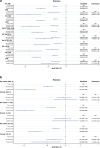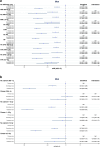The impact of education level on all-cause mortality in patients with atrial fibrillation
- PMID: 39455584
- PMCID: PMC11511939
- DOI: 10.1038/s41598-024-74478-2
The impact of education level on all-cause mortality in patients with atrial fibrillation
Abstract
The association of socioeconomic status with cardiovascular morbidity and mortality is well known, but data on the influence of education level on mortality in individuals with atrial fibrillation (AF) are scarce. We investigated education level as a predictor of all-cause mortality in patients diagnosed with AF. This retrospective cohort study used a database created from several Swedish nationwide registries to identify all patients hospitalized with a diagnosis of AF hospitalized from 1995 to 2008. Education level was categorized as primary, secondary, and academic. All-cause mortality risk was estimated in subpopulations defined by the Charlson Comorbidity Index and several comorbidities. A total of 272,182 patients (56% male; mean age 72 ± 10 years) were followed for five years. Cox regression models showed a reduction in all-cause mortality risk with increased education level. Hazard ratios (HR) relative to primary education remained significant after stratification and adjustment for several confounders: secondary education HR = 0.88; 95% CI: 0.86-0.89; P < 0.001; academic education HR = 0.70; 95% CI: 0.67-0.72; P < 0.001. Subpopulation analyses confirmed a significant reduction in relative risk with higher education level. Targeted screening and education programs could be effective in reducing mortality in AF patients with fewer years of formal education.
Keywords: All-cause mortality; Atrial fibrillation; Education level; Socioeconomic status.
© 2024. The Author(s).
Conflict of interest statement
The authors declare no competing interests.
Figures



Similar articles
-
Educational inequalities in mortality of patients with atrial fibrillation in Norway.Scand Cardiovasc J. 2017 Apr;51(2):82-87. doi: 10.1080/14017431.2016.1268711. Epub 2016 Dec 25. Scand Cardiovasc J. 2017. PMID: 27918197
-
Socioeconomic factors and mortality in patients with atrial fibrillation-a cohort study in Swedish primary care.Eur J Public Health. 2018 Dec 1;28(6):1103-1109. doi: 10.1093/eurpub/cky075. Eur J Public Health. 2018. PMID: 29746622 Free PMC article.
-
Angiotensin-Converting Enzyme Inhibitors and Angiotensin II Receptor Blockers Are Associated With Improved Outcome but Do Not Prevent New-Onset Atrial Fibrillation After Acute Myocardial Infarction.J Am Heart Assoc. 2017 Mar 20;6(3):e005165. doi: 10.1161/JAHA.116.005165. J Am Heart Assoc. 2017. PMID: 28320744 Free PMC article.
-
Depression or anxiety and all-cause mortality in adults with atrial fibrillation--A cohort study in Swedish primary care.Ann Med. 2016;48(1-2):59-66. doi: 10.3109/07853890.2015.1132842. Epub 2016 Jan 13. Ann Med. 2016. PMID: 26758363 Free PMC article.
-
Atrial fibrillation and stroke. Mortality and causes of death after the first acute ischemic stroke.Stroke. 1997 Feb;28(2):311-5. doi: 10.1161/01.str.28.2.311. Stroke. 1997. PMID: 9040681 Review.
Cited by
-
Assessing level of awareness of atrial fibrillation among general public: a cross-sectional study.BMC Cardiovasc Disord. 2025 Apr 7;25(1):265. doi: 10.1186/s12872-025-04720-w. BMC Cardiovasc Disord. 2025. PMID: 40189528 Free PMC article.
References
-
- Rangarajan, S. et al. Socioeconomic status and risk of cardiovascular disease in 20 low-income, middle-income, and high-income countries: the Prospective Urban Rural Epidemiologic (PURE) study. Lancet Glob Heal7, e748-60 (2019). - PubMed
-
- Havranek, E. P. et al. Social determinants of risk and outcomes for cardiovascular disease: A scientific statement from the American Heart Association. Circulation132, 873–98 (2015). - PubMed
-
- Goli, N. M. et al. Educational attainment is associated with atrial fibrillation symptom severity. PACE - Pacing Clin Electrophysiol35, 1090–6 (2012). - PubMed
MeSH terms
LinkOut - more resources
Full Text Sources
Medical

